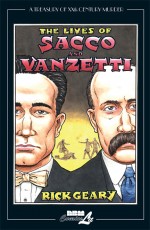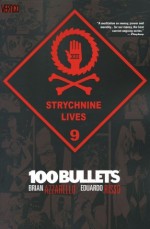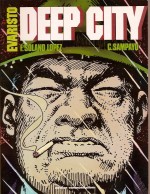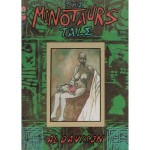
By various (Fantagraphics Books)
ISBN: 978-1-60699-395-8
Mome was a quarterly compendium of sequential narratives; a magazine that looked like a book, featuring strips, articles, graphic artworks and sometimes interviews from and about a variety of talented, dedicated creators ranging from the internationally renowned to the soon-to-be. It was where the smart kids with the sharpest pencils, shiniest pens, biggest brushes and best software went to play before they blew our minds in great big award-winning graphic novels. It was intense, sometimes hard to read and crafted to the highest production standards.
I’m using the past tense here because tragically the amazing anthological compendium closes with this bonanza-sized final edition after six eye-popping, parameter-expanding years: another economic casualty of those globalizing fat-cat banking bastards… curse them all and the artificially-expensive, sweat-shop produced shoes they smugly skulk in!
With a promise that the unfinished serials will eventually be concluded in their own graphic novel compilations this last bombastic book opens with an ending – of sorts – for Kurt Wolfgang’s delicious ‘Nothing Eve’ expediently assisted by self-professed “art-whore†Jordan Crane, after which Chuck Forsman produces a moving stand alone rumination on the young Freelancer’s existence in ‘Francis’.
Guns ‘n’ Roses, Kiss and other rock-god types get a working over in a number of hilarious single page assaults by Steven Weissman beginning with ‘Soup ‘n’ ½ Sandwich’ followed by Sara Edward-Corbett’s captivating childhood paean ‘The Blunderous Companion’ and Laura Park’s darkly wicked ‘George’.
Tom Kaczynski proffers some sage movie-making advice in ‘Music for Neanderthals’, Weissman describes an ‘Appetite for Delicatessen’ and Joe Kimball spectacularly reveals the magic of the ‘Secret Hand’ after which ‘Ham ‘n’ Tashen’ follows, taking Weissman’s musical obsession to ludicrous heights – and depths…
The wildly imaginative fable ‘Simon Magus’ by Jesse Moynihan is followed by a too-brief fourth instalment of The (Shaun) Partridge in the Pear Tree & Josh Simmons’ fantasy-epic ‘The White Rhino’ (we’ll have to wait for a conclusion in the promised graphic novel one day) and a powerful tale of the dangers of “going native†in ‘Hero of Science’ by Malachi Ward, whilst Eleanor Davis recounts a poignant tale of loss and abiding endurance in ‘Nita Goes Home’…
James Romberger shocks and delights with the daring ‘Loving Bin Laden’ after which and extra-long chapter by Derek Van Gieson & Michael Jada concludes the moody World War II mystery ‘Devil Doll’. Weissman resurfaces with ‘Chinese Chicken Salad Democracy’ before Tim Lane presents an earnest biographical tale of a WWII ‘Belly Gunner’ and Nate Neal scrupulously examines the pros and cons of ‘Death’…
Josh Simmons waxes theological with ‘We Enjoyed Many Adventures’ and then joins Wendy Chin to relate the salutary endings of ‘Axl & Jim’. Following Weissman’s (?) ‘Peter Criss Diary’ come Anders Nilsen’s contemplative collage ‘Lists and Commentary’ whilst in ‘Sir Alfred’ film director Hitchcock’s life and work endures a delightful cartoon roasting by Tim Hensley, and Weissman strikes again with ‘Jews Your Illusion’.
Lille Carré delights and enthrals with ‘Into the Night’, T. Edward Bak’s pictorial biography of 18th century German naturalist Georg Wilhelm Steller forges ever onward in ‘Wild Man Chapter 3: Beasts of the Sea part 2’ (another saga to be concluded elsewhere) and Nick Drnaso’s ‘Keith or Steve’ wittily explores the suburban lifestyle. ‘List of Lasts’ by Joseph Lambert captivatingly captures our childhood obsessions before Paul Hornschemeier beguiles and enthrals with ‘Amy & Paul’ and Sergio Ponchione reprises his marvellously madcap horror-hunter Professor Hackensack with ‘Fear, Thy Name is Foursquare!’…
Malachi Ward resurfaces with philosophical future history ‘1211N.E. (New Era)’ and Nick Thorburn contributes a recollection of music festival fun in an untitled piece before Dash Shaw shows everybody up with another oddly enticing adaptation of TV at its worst in ‘Blind Date 3’ (“an adaptation of an episode of Blind Dateâ€) after which Ted Stern’s anthropomorphic sad-sacks Fuzz & Pluck return in their ongoing nautical quest for wealth and safety with the fifth chapter of ‘The Moolah Tree’ – one more to wait for in album format…
‘Suburban Love Tales, Number 10, Page 3’ is a moody midnight encounter from Jim Rugg, Victor Kerlow offers a growing peril in ‘Oh Man’, Noah Van Sciver details both sides of the story in ‘Roommates’ and the wonderment sadly ceases with a true hard knocks tale in ‘Unlucky’
With bios of contributors and a full list of all who’ve graced this glorious project over the last six years the experiment ends but even though gone this superb, bold endeavour mustn’t be forgotten. There are plenty of places to still find back issues and these tomes – especially this double-sized delight – would make captivating Christmas presents.
Mome © 2011 Fantagraphics Books. Individual stories are © the respective creator. All rights reserved.










